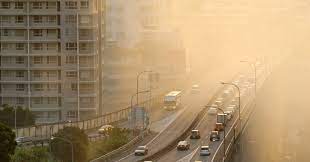To address the deteriorating winter air quality in Delhi caused by environmental and human factors, CAQM (Commission for Air Quality Management in NCR) conducted a review meeting on September 26, 2023, with prominent officials from the Delhi government, following its revisions to the Graded Response Action Plan (GRAP) in July 2023. Here are the main highlights from the meeting:
- The GRAP (Graded Response Action Plan) outlines 27 actions for Stage – I, 11 for Stage – II, 08 for Stage – III, and 08 for Stage – IV. Actions include mechanized sweeping, anti-smog guns, water sprinkling, PUC norms enforcement, controlled DG set usage, power supply stability, restrictions on certain vehicles like end-of-life and BS III/IV petrol/diesel vehicles.
- GNCT of Delhi operates 7,041 buses: 4,088 DTC buses and 2,953 cluster buses. This fleet includes 456 e-buses and 94 mini electric buses. Plans are in place to enhance public transport with 850 more buses by September 2023 and an additional 650 buses by March 2024. As of September 23, 2023, Delhi has 943 operational PUC (Pollution Under Control) certification stations, issuing a total of 33.56 lakh PUC certificates in the NCR.
- Delhi has over 2.38 lakh registered EVs as of September 22, 2023, supported by 3,100 charging stations, 4,793 charging points, and 318 swapping stations, with plans to establish 18,000 public and 30,000 private/semi-public charging stations by 2025.
- GRAP includes actionable points for citizens during different stages of air pollution.
- Delhi employs 83 Mechanical Road Sweeping (MRS) machines that sweep an average of 2,700 km of road daily, collecting and disposing of about 125 metric tonnes of road dust. Additionally, 320 water sprinklers cover an average of 2,600 km of road daily. Augmenting the capacity and intensification of mechanized road sweeping and water sprinkling were advised.
- Delhi currently deploys 389 Anti-Smog Guns (ASG) to control dust in various areas, including buildings, roads, and open spaces, with additional ASGs at C & D sites. Of over 90 high-rise buildings identified for ASG deployment, 47 government and 43 private high-rises have already been equipped. Government departments such as MCD, DCB, DDA, NDMC, PWD, NHAI, NBCC, CPWD, among others, have received directives to identify more high-rise buildings for ASG installation.
- Strict enforcement of government/court orders on firecrackers during festivals and the paddy harvesting season is emphasized.
- Delhi has identified 13 hotspots for pollution control namely Anand Vihar, Mundka, Wazirpur, Jahangirpuri, R K Puram, Rohini, Punjabi Bagh, Okhla, Bawana, Vivek Vihar, Narela, Ashok Vihar and Dwarka. Comprehensive identification of major air pollution sources in hotspots has been finalized to facilitate targeted preventive measures. The implementation plan includes appointing dedicated Nodal Officers to tackle air pollution issues in these hotspots.





